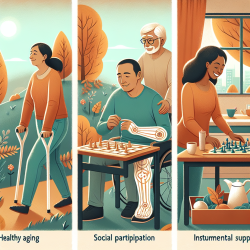Introduction
As practitioners dedicated to the well-being of children, understanding the complex interplay of factors that contribute to resilience in youth with chronic illnesses is paramount. The narrative review titled "Utilizing a multisystemic model of resilience to synthesize research in youth with inflammatory bowel disease" offers valuable insights into this area. By adopting a multisystemic framework, practitioners can enhance their approach to fostering resilience in youth with inflammatory bowel disease (IBD).
Understanding the Multisystemic Model
The multisystemic model of resilience, as proposed by Ungar, emphasizes the importance of considering both individual and contextual factors in understanding resilience. This model is organized into three dimensions:
- Contexts of Risk Exposure: This dimension includes disease-specific, demographic, and sociocultural factors that contribute to risk exposure in youth with IBD.
- Protective and Promotive Factors/Processes (PPFPs): These are the intra- and inter-personal factors that facilitate well-being in the presence of adversity.
- Desired Outcomes: These outcomes encompass both the absence of negative indicators and the presence of positive ones.
Applying the Model in Practice
Practitioners can enhance their skills by integrating the multisystemic model into their practice. Here are some practical steps:
- Assess Risk Contexts: Evaluate the specific risk exposures faced by youth with IBD, including disease severity and sociocultural factors.
- Identify PPFPs: Recognize and strengthen protective factors at individual, familial, peer, school, and community levels.
- Focus on Desired Outcomes: Aim to achieve both recovery (absence of negative outcomes) and sustainability (presence of positive outcomes) in youth with IBD.
Encouraging Further Research
The narrative review highlights existing gaps in knowledge and provides a foundation for future research. Practitioners are encouraged to contribute to this evolving field by exploring the following areas:
- Longitudinal studies to understand the dynamic nature of resilience in youth with IBD.
- Qualitative research to capture the nuanced experiences of young individuals with IBD.
- Intervention studies to test the effectiveness of multisystemic approaches in promoting resilience.
Conclusion
By adopting a multisystemic approach, practitioners can better understand and support resilience in youth with IBD. This model provides a comprehensive framework for addressing the complex needs of this population, ultimately leading to improved outcomes. For those interested in delving deeper into this topic, I highly recommend reading the original research paper.
To read the original research paper, please follow this link: Utilizing a multisystemic model of resilience to synthesize research in youth with inflammatory bowel disease: a narrative review.










